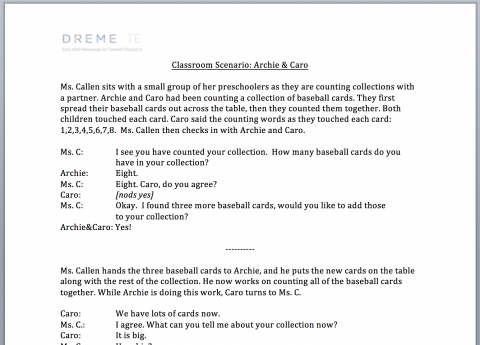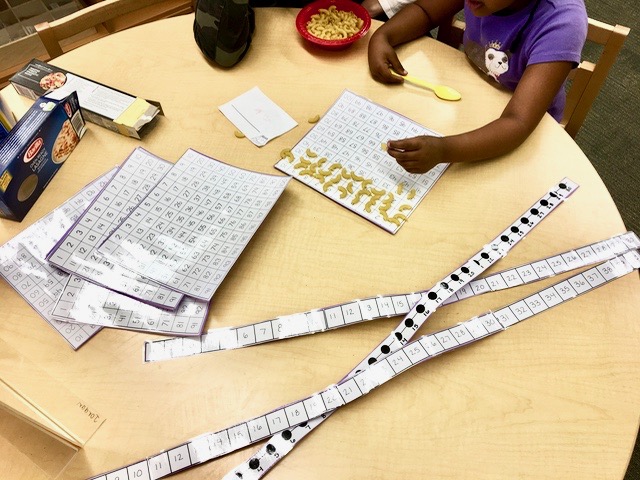Attending to the nuance of children’s responses enables teachers to figure out what children understand and what questions and supports can help them extend their thinking. Figuring out which questions to ask, which tasks to pose, and which tools to offer is often the most challenging aspect of teaching mathematics. This activity engages participants in both attending to the details of children’s ideas and working on how to support children to think more deeply.
by Megan Franke
Activity for Teacher Educators
In this activity, participants read a classroom-based scenario in which Archie and Caro are counting a collection together. We provide some suggested pause activities that help participants engage more deeply with the scenario. We encourage you to ask participants to engage with the first portion of the scenario only, then do the pause activity together before moving onto the next portion of the interchange. Each pause activity is described below and takes on the same structure: 1) have participants fully detail what they noticed about what the children did, and 2) ask the participants to generate a number of possible moves to support further thinking.
Classroom Scenario: Archie and Caro
 Ms. Callen sits with a small group of her preschoolers as they are counting collections with a partner. Archie and Caro had been counting a collection of baseball cards. They first spread their baseball cards out across the table, then they counted them together. Both children touched each card. Caro said the counting words as they touched each card: "One, two, three, four, five, six, seven, eight." Ms. Callen then checks in with Archie and Caro.
Ms. Callen sits with a small group of her preschoolers as they are counting collections with a partner. Archie and Caro had been counting a collection of baseball cards. They first spread their baseball cards out across the table, then they counted them together. Both children touched each card. Caro said the counting words as they touched each card: "One, two, three, four, five, six, seven, eight." Ms. Callen then checks in with Archie and Caro.
Ms. C: I see you have counted your collection. How many baseball cards do you have in your collection?
Archie: Eight.
Ms. C: Eight. Caro, do you agree?
Caro: [nods yes]
Ms. C: Okay. I found three more baseball cards, would you like to add those to your collection?
Archie and Caro: Yes!
---Pause 1---
Ms. Callen hands the three baseball cards to Archie, and he puts the new cards on the table along with the rest of the collection. He now works on counting all of the baseball cards together. While Archie is doing this work, Caro turns to Ms. C.
Caro: We have lots of cards now.
Ms. C.: I agree. What can you tell me about your collection now?
Caro: It is big.
Ms. C. How big?
Caro: Bigger than my first one.
---Pause 2---
Ms. C: Archie, I noticed you were doing something with the collection to find out how many you have now. Can you tell us what you were doing?
Archie: I counted them.
Ms. C: Can you tell us how you counted them?
Archie: I had the eight and then I counted the new ones too. I pushed them together and then I counted again.
Ms. C: Can you show us how you counted?
Archie: [pointing to each card as he counts] One, two, three, four, five, six, seven, eight, nine, ten, eleven.
Ms. M.: Caro, did you see what Archie did?
Caro: [nods yes]
Ms. C: So, Archie and Caro, how many are in your collection of baseball cards now?
Archie and Caro: Eleven.
Ms. C: Is your new collection larger or smaller than the collection you started with?
---Pause 3---
[End of Classroom Scenario]
Pause Activities
PAUSE 1
Ask the group what they know so far about the situation and about Caro and Archie’s thinking. Consider together how Caro and Archie might respond to adding three more objects to their collection.
Prompt them to notice, if they do not on their own, that Archie took all of their cards and spread them out (in no particular organizational scheme) but kept track of which they had counted to get the total of eight. They together show one-to-one correspondence, cardinality, the counting sequence, and knowing how to count the entire set. Note also the questions Ms. Callen asked. She allowed the children to take the lead and explain or show what they were doing and thinking. She asked questions such as, “Can you show us how you counted them?”
PAUSE 2
Ask the participants to turn and talk with a partner about their observations of what Archie and Caro are doing and saying, what they would want to ask Archie, and what they would ask Caro. Bring them back together as a whole group to discuss.
Note that while Caro does not combine and count all of the baseball cards when she is given three more, she does recognize that it is more than she had before, which is an important part of beginning to understand joining. We would not want to push her to add them and count. We want to support her to continue talking about what is happening, perhaps adding one more card to see what she would say.
After discussing the above questions, continue with the following: Archie and Caro counted eight cards and Ms. Callen offered them three more cards to add to their collection. What size collection and what kinds of problems would you pose next to Archie next? What about to Caro?
Since Archie can combine all his cards and count them up together (a count all strategy) he is likely able to do the same with adding more than three. He is likely able to deal with some cards being taken away as well. He may be able to share his collection with one other person so they each have the same amount. Asking him to compare, however, may lead to different results because he might not easily know how to figure that out with his collection. Another productive follow-up would be to add one more baseball card and see if Archie attempts to count on without having to recount the original set of cards.
PAUSE 3
Ask participants, "How did Archie figure out how many baseball cards were in his collection? How do you know?"
Archie counted all of his cards. He started by combining his original collection with the three new cards at then started at one, counting all of the cards until he got to eleven. He knew eleven represented all the cards in his new collection.
Also ask, "Knowing how he solved the problem of joining three more cards, are there other kinds of problems you might ask when he counts his next collection?"



